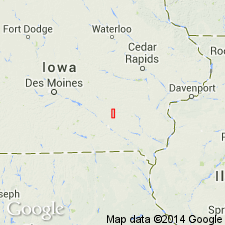
- Usage in publication:
-
- Waugh Member
- Modifications:
-
- Named
- Reference
- Dominant lithology:
-
- Sandstone
- Mudstone
- Shale
- AAPG geologic province:
-
- Iowa shelf
Summary:
Named [by McKay] as upper member (of 3) of the IA St. Louis Formation; named from the Waugh Branch, a tributary to the South Skunk River, southwestern Keokuk Co, IA on the Iowa shelf. Type area within secs 13 and 14, T74N, R13W, Hedrick quad, Keokuk Co. Reference sections at Showman Station Quarry and railroad cut, Kessel property, Waugh Branch streamcut, Taylor Quarry--field trip stops--described on p. 55-57, 59-61, 62-69, 72-73. Occurs in the Keokuk Co area. Major lithofacies are (ascending order): 1) planar to cross-stratified sandstones with thin laminated lime mudstones in upper part; 2) sandy shales; 3) massive, fractured to brecciated, and intraclastic to conglomeratic, ostracode-fish-bearing lime mudstones; 4) thin- to thick-bedded, partly laminated, ostracode-fish-bearing lime mudstones interbedded with shale; and 5) scale tree root-bearing sandstone and associated underclay. Minor lithofacies are: 1) tetrapod-bearing limestone conglomerate; and 2) tetrapod-bearing boulder conglomerate. Thickness varies, in study area, from 15-20 ft. Overlies Verdi Member of St. Louis Formation disconformably; underlies Pella Formation. Fossils--ostracods, snails, root casts (STIGMARIA), fish sharks, and tetrapods --listed. Deposited in environments of fluvial, marginal marine, deltaic, lagoonal type. Cross sections. Of Late Mississippian age.
Source: GNU records (USGS DDS-6; Denver GNULEX).
For more information, please contact Nancy Stamm, Geologic Names Committee Secretary.
Asterisk (*) indicates published by U.S. Geological Survey authors.
"No current usage" (†) implies that a name has been abandoned or has fallen into disuse. Former usage and, if known, replacement name given in parentheses ( ).
Slash (/) indicates name conflicts with nomenclatural guidelines (CSN, 1933; ACSN, 1961, 1970; NACSN, 1983, 2005, 2021). May be explained within brackets ([ ]).

